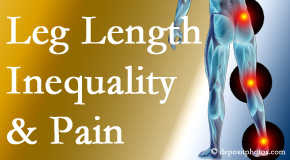Leg Length Inequality Is Checked at Layden Chiropractic for its Effect on Back, Hip and Knee Pain
Leg length inequality is prevalent. A short leg affects joints in the hip, knee and spine. Knee, hip and back pain may follow. The Plainville chiropractic examination at Layden Chiropractic incorporates a test for leg length inequality and, subject to the discrepancy, the Plainville chiropractic treatment plan will fix it with a heel lift to potentially avoid issues like hip joint arthritic degeneration, knee and back pain.
SURPRISING FACTS ABOUT INCIDENCE OF SHORT LEG
No one shares that he or she has one shorter leg than the other. It is not a usual conversation starter! But 90% of us has an inequality of greater than 1 cm! Only 10% of us has precisely equal leg lengths. Just 10%! Leg length inequality equalizes us all.
- Hip and knee issues emerge in more patients who have leg length differences over 5 mm.
- Hip issues typically occur in the long leg side. Knee conditions are more apt to be more typical in either leg – shorter or longer.
- Low back problems happen more commonly on the short leg side.
PREVENTION OF HIP JOINT ARTHRITIC DEGENERATION
Want to prevent hip joint arthritic degeneration? Young and old alike do. Those who have a short leg, the contact forces in the joints in the short leg were increased as the leg length difference increased. The greater the difference, the greater the contact forces in the short leg. Why does this matter? These forces wear on the hip joint the most as the leg length difference increases. (2) The older of us will want to prevent further irritation, and the younger of us will want to prevent long-term exposure to irritation and future joint degeneration. A short leg bothers our joints.
Plainville CHIROPRACTIC CARE OF SHORT LEG
Chiropractors like yours at Layden Chiropractic know short legs affect knees, backs and hips. We were trained in chiropractic school to notice important issues like leg length inequality and deal with them. Chiropractors notice that correction of leg length difference of 5 mm or more is positive. The goal is to have no more than 3 mm of leg length difference, and heel lifts are used to correct up to 9 mm difference while a 10 mm or more requires a shoe build-up of the full difference under the heel and 50% the difference under the sole. (1) Chiropractic education has always included the diagnosis and treatment of short leg differences. It’s important that to know that an xray Is not required to establish and correct short leg syndrome. We can do it by “pelvic leveling,” a technique your Plainville chiropractor can do it for you. Get this important anatomical factor for good spinal and general health measured by your chiropractor so proper correction can be made. Keep in mind, chiropractors like yours at Layden Chiropractic see more than the general percent of persons with short leg because it causes spine pain. Layden Chiropractic sees and treats a lot of spine pain! Consequently, by correcting short leg difference in younger years of life, we can prevent degenerative conditions of the spine and extremities that cause pain and disability in middle age and beyond.
CONTACT Layden Chiropractic
Check out podcasts of patient cases and conditions on The Back Doctors Podcast with Dr. Michael Johnson to hear how effectively Cox® Technic addresses back pain and brings relief for a multitude of spine-related pain conditions.
Schedule your Plainville chiropractic appointment. Layden Chiropractic will welcome you as a member of the 90%-of-people-have-a-short leg group…or not! Rely on Layden Chiropractic to help you with all your spine issues!

